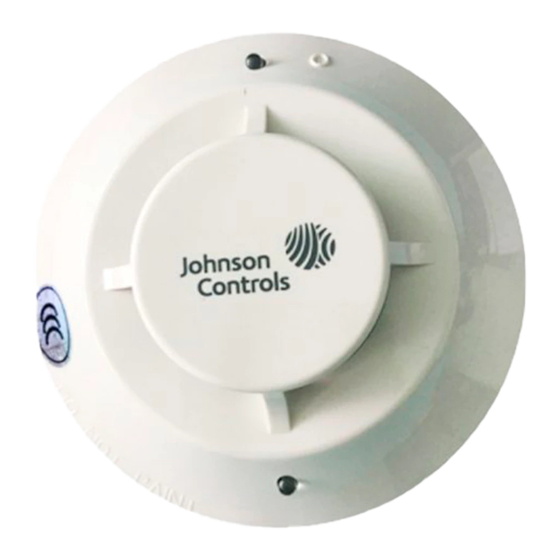Table of Contents
Advertisement
Quick Links
2951J, 2951TJ and 2951TMJ Intelligent Photoelectric Smoke Sensors
This sensor must be installed in compliance with the control panel system installation manual. The installation must meet the requirements of the Authority
Having Jurisdiction (AHJ). Sensors offer maximum performance when installed in compliance with the National Fire Protection Association (NFPA); see NFPA
72.
GENERAL DESCRIPTION
Model 2951J, 2951TJ and 2951TMJ are intelligent sensors that combine a state-of-the-art photoelectronic sensing chamber with communications. Models
2951TMJ and 2951TJ combines a photoelectronic sensing chamber and 135°F (57.2°C) fixed temperature heat detector. These sensors are designed to provide
open area protection and are intended for use with compatible control panels only.
Two LEDs on each sensor light to provide a local, visible sensor indication. Remote LED annunciator capability is available as an optional accessory (Part No.
RA400Z). The sensor will support either FlashScan™ or CLIP (Classic Loop Interface Protocol) SLC communication mode.
Johnson Controls panels offer different feature sets across different models. As a result, certain features of the 2951J, 2951TJ or 2951TMJ may be available on
some control panels, but not on others. The possible features available in the 2951J, 2951TJ and 2951TMJ, if supported by the control unit are:
1. The panel controls the LED operation on the sensor. Operational modes are RED blink, RED continuous, GREEN blink, GREEN continuous, and off.
2. The remote output may be synchronized to the LED operation or controlled independent of the LEDs.
SPECIFICATIONS
Operating Voltage Range:
Standby Current:
Max. Alarm Current (LED on):
Operating Humidity Range:
Operating Temperature Range:
Height:
Diameter:
Weight:
SPACING
Johnson Controls recommends spacing sensors in compliance with NFPA 72. In low air flow applications with smooth ceilings, space sensors 30 feet apart.
For specific information regarding sensor spacing, placement, and special applications, refer to NFPA 72 or the System Smoke Detector Application Guide,
(A05-103-XX) available from Johnson Controls.
Duct Applications: 2951J and 2951TJ are listed for use in ducts. See Duct Applications Guide A05-1004 for details on pendant mount applications.
NOTE: These products are not listed for use inside duct smoke detectors.
WIRING INSTRUCTIONS
All wiring must be installed in compliance with the National Electrical Code, applicable
local codes, and any special requirements of the Authority Having Jurisdiction. Proper
wire gauges should be used. The installation wires should be color-coded to limit wiring
mistakes and ease system troubleshooting. Improper connections will prevent a system
from responding properly in the event of a fire.
Disconnect power from the SLC communication line before installing sensors.
1. Wire the sensor base (supplied separately) per the wiring diagram (Figure 1).
2. Set the desired SLC address on the sensor address switches.
NOTE: Some panels support extended SLC addressing. In order to set the sensor
above address 99 on compatible systems, carefully remove the stop on the upper
rotary switch with thumb or finger as shown in Figure 2.
3. Install the sensor into the sensor base. Push the sensor into the base while turning it
clockwise to secure it in place.
4. After all sensors have been installed, apply power to the control unit and activate the
communication line.
5. Test the sensor(s) as described in the TESTING section of this manual.
Dust covers provide limited protection against airborne dust particles during shipping. Dust covers must be
removed before the sensors can sense smoke. Remove sensors prior to heavy remodeling or construction.
TAMPER-RESISTANCE
Models 2951J, 2951TJ and 2951TMJ include a tamper-resistant capability that prevents their removal from the
bracket without the use of a tool. Refer to the base manual for details on making use of this capability.
TESTING
Before testing, notify the proper authorities that the system is undergoing maintenance, and will temporarily be out
of service. Disable the system to prevent unwanted alarms.
All sensors must be tested after installation and periodically thereafter. Testing methods must satisfy the Authority
Having Jurisdiction (AHJ). Sensors offer maximum performance when tested and maintained in compliance with
NFPA 72. The sensor can be tested in the following ways:
A. Functional: Magnet Test (P/N M02-04-01 or M02-09-00)
J200-07-00
Installation and Maintenance Instructions
15 to 32 VDC
300µA @ 24 VDC (one communication every 5 seconds with LED blink enabled)
6.5 mA @ 24 VDC
10% to 93% Relative Humidity, noncondensing
0° to 49°C (32° to 120°F); 2951J
0° to 38°C (32° to 100°F); 2951TJ and 2951TMJ
2.0 inches (51 mm) installed in B210LPJ and B501J Bases
6.1 inches (155 mm) installed in B210LPJ Base
4.1 inches (104 mm) installed in B501J Base
5.2 oz. (147 gm)
CAUTION
+
-
-
+
1
Johnson Controls Inc., 507 E. Michigan St., Milwaukee, WI 53201
REMOTE ANNUNCIATOR
+
-
2
3
3
1
OPTIONAL RETURN LOOP
Figure 1. Wiring Diagram
Breakaway Stop
7
8
9
6
5
5
10
11
4
4
12
3
3
13
2
2
14
1 0
15
TENS
Figure 2. Rotary SLC Address Switches
I56-1930-02R
2
1
C0147-00
7
8
6
9
1 0
ONES
C0162-00
Advertisement
Table of Contents

Summary of Contents for Johnson Controls 2951J
- Page 1 RA400Z). The sensor will support either FlashScan™ or CLIP (Classic Loop Interface Protocol) SLC communication mode. Johnson Controls panels offer different feature sets across different models. As a result, certain features of the 2951J, 2951TJ or 2951TMJ may be available on some control panels, but not on others.
- Page 2 Cover to ensure that the detector’s environment is suitable for this setting. The following steps must be followed to meet Johnson Controls and UL requirements for this high sensitivity application: 1. Each detector intended for 0.2% to 0.5% per foot alarm application shall have Sensing its initial alarm setting set for 0.5% obscuration per foot alarm level.













Need help?
Do you have a question about the 2951J and is the answer not in the manual?
Questions and answers